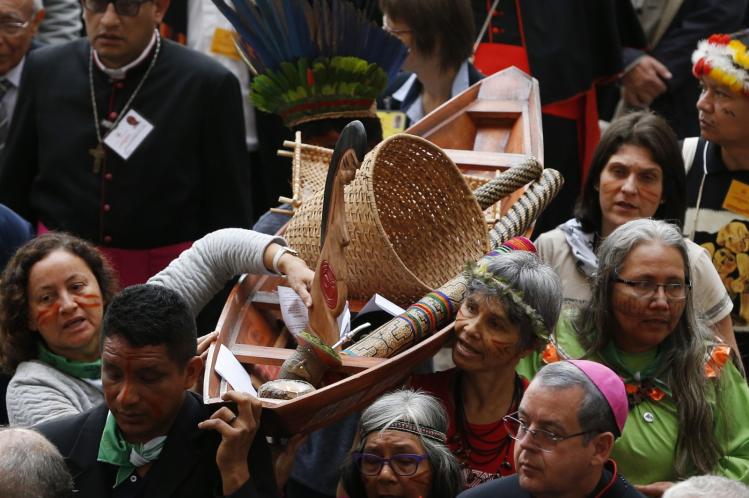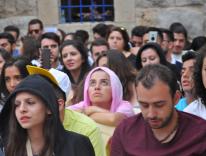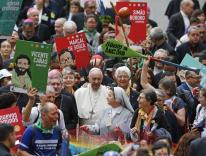
The opening days of the Amazon Synod have been marked by the familiar polar tensions at the heart of the Catholic Church: between center and periphery, universal and local; between the demands of the law and the pastoral needs of a particular people. But now there is something new, something that is tilting the balance in favor of the peripheral, the local, and the particular.
You could see it happening in the gentle battle over liturgical space in the run-up to the synod’s opening. On October 4 in the Vatican Gardens and on the following night at a church not far from St Peter’s, dozens of indigenous leaders and church workers led offerings and prayers, using objects and forms of worship from the region: a canoe, a mandorla, the image of a pregnant woman, as well as placards of Amazon martrys such as Sr. Dorothy Stang. It was joyful, generous, and unmistakably Amazonian: the faithful People of God speaking and praying and dancing in their own way.
Yet at the big papal Mass in St Peter’s the next morning, Amazonia was all but banished. If the pope in his zinger homily hadn’t invoked the Holy Spirit to “renew the paths of the Church in Amazonia, so that the fire of mission will continue to burn,” you would have had no idea the synod was even taking place. Indigenous leaders sat at the front and brought up the gifts but were silent: there were no intercessions for the region, no readings in an Amerindian language, and almost everything was Italian and solemn. The center was back in charge.
But not for long. The next morning the Amazonian people were in St. Peter’s Basilica with Pope Francis, along with the canoe and the martyrs and Our Lady of the Amazon. In a remarkable move, unprecedented at previous synods, the pope processed from the Basilica with the indigenous peoples, in their midst—el pastor con su pueblo—as they joyfully chanted, “The sons and daughters of the Forest, we praise you, Lord.”
As they left St. Peter’s and crossed the square to the synod hall, I thought of Jeremy Irons in Roland Joffé’s film The Mission, the Jesuit who walks with his people into a hail of colonialist bullets. There had been no shortage of rhetorical bullets in the run-up to the synod: superannuated cardinals telling Amazonian Catholics they were heretics for proposing to ordain married men; a panel of traditionalists (Cardinal Burke in the front row) claiming the synod would not “civilize the savages” but would instead “make the civilized savages”; and an EWTN-owned news outlet reporting that the ceremony in the Vatican Gardens—in which native peoples honored God’s creation—was an essentially pagan, pantheistic affair. In his speech opening the synod, the pope spoke of his pain at overhearing someone at the previous day’s Mass mock the feather headdress of the leader who brought the gifts to the altar. “Tell me,” the pope asked the 300-odd participants, “what difference is there between wearing feathers on your head and the three-cornered hat used by some officials in our curial departments?”
In that opening address Francis was clear about where he and the synod would stand. They would look at the Amazon region with the eyes of disciples and missionaries, respectful of the ancestral wisdom and culture of its peoples, and rejecting any approach that was colonialist, ideological, or exploitative. They would not try to “discipline” the locals. For whenever the church has had this mindset, Francis warned, it has failed utterly to evangelize. The Jesuit pope reminded the synod’s participants of the ill-fated sixteenth-century missions of the Jesuits Roberto Di Nobili, SJ, and Matteo Ricci, SJ, whose bold attempts at inculturation, in India and China respectively, were quashed by the pettiness and colonialist mindsets of church leaders at the time. Without being planted in the local culture, the Gospel cannot take root: “homogenizing centralism,” said Francis, is the enemy of “the authenticity of the culture of the peoples.” This synod would go the other way. “We come to contemplate, to understand, to serve the peoples.”
What matters, then, is the people of Amazonia, and especially the 3 million or so indigenous gathered in 390 peoples who, for the first time, are the central concern of a synod. It is their welfare, their pastoral needs, that are at the heart of this gathering, as well as the natural world to which they are deeply, symbiotically connected. Both are threatened with destruction as never before. This life-or-death urgency demands, in turn, that the church examine the nature of its presence, how it can be embedded and inculturated, how it can it stand with, and promote the life of, its peoples in an area where one “regional vicariate” might be the size of half of Italy yet have just a handful of priests.
The issue is one of agency. The synod is a test of the church’s ability to implement the vision of Laudato si’ in a region that almost daily dramatizes that encyclical’s call to conversion. Cardinal Michael Czerny, SJ—a key drafter of Laudato si’ who will also be drawing up the final document on which the synod will vote on October 26—told Commonweal that because “the Amazon region exemplifies the inextricable connection between the social and natural environments, the fate of people there and of their natural surroundings” there could be “no more concrete manner than this [synod] to lift Laudato si’ off the page and put it into action.”
This is the first ever “territorial” synod. More than 80,000 people were consulted in preparation for it. The bishops who make up the overwhelming majority of its 185 voting members are there not because their national bishops’ conferences chose them as delegates, but because their dioceses are in Amazonia. The bishops may be from nine different nations (there are fifty-eight Brazilians, fourteen Colombians, twelve Bolivians, eleven Peruvians, seven Ecuadorians, seven Venezuelans, plus four from the Antilles) and speak four different languages, but they have far more in common with one another than with many members of their own national conferences. (“The bishops in the south,” a Brazilian Amazonian bishop lamented to me, “haven’t got a clue what we face. I have much more in common with a Peruvian or Bolivian Amazonian bishop.”) Meanwhile, the other voting delegates—fifteen elected by the missionary religious orders, thirty-three chosen by the pope—are either embedded in the area or deeply sympathetic to it. That leaves just thirteen heads of curial departments as jokers in the pack.
This doesn’t mean, of course, that there is automatically a consensus; most bishops agree on the challenges—the working document captures them brilliantly—but most have not arrived in Rome with a list of solutions. Yet my informal soundings of Amazonian bishops and those who know them well suggest that around two-thirds of them are wholly supportive of the synod and its proposals for the ordination of elders and some kind of recognition of women’s ministries. Bishop Erwin Krautler, the retired bishop of Xingú, confirmed that two-thirds figure on Wednesday, and argued there was no choice but to ordain married elders if the church wants a stable, autochthonous clergy in the region.
The other third are said to be more tentative, waiting to see what emerges. There is even a small rump of conservative resistance, centered in the Brazilian archdiocese of Belém do Pará. While his rhetoric is a long way from the astonishing attacks on the synod—“Heretical! Pantheistic!”—of Cardinals Burke, Müller and Brandmüller, Dom Taveira Corrêa and his auxiliaries have been less than enthusiastic participants in the pre-synod consultation process, with the archbishop complaining about the need for “more evangelism and less ecologism.”
Yet it is precisely evangelization—the spread and deepening of Catholic life and spirituality—that this synod is designed to improve. Most Amazonian native peoples live not in parishes but in remote village-size communities with strong social structures. Religious life is entrusted to the community’s leaders; they are likely to be the catechists and “animators” of the local church. A missionary priest might pass through once or twice a year, to celebrate Mass and hear confessions, which is a cause for great celebration. But the rest of the time, in their gathering round the Word alone, the Catholic Amazonians look indistinguishable from Evangelicals. All too often priests arrive to find that the whole village leadership has succumbed to what a synod father has described as “the dizzying proliferation of Pentecostal churches.” Nowadays these are likely to be powerful megachurches that proselytize aggressively and preach a version of the Prosperity Gospel.
The threat from the Pentecostals is a delicate subject. Few talk about it openly at the synod, because to do so is considered politically incorrect. The European missionary priest who spelled the problem out to me asked not to be identified by name or nationality.
“The indigenous Catholic communities in the Amazon today are among the best reflections of the first Christian communities in the Acts of the Apostles,” he told me. “It’s natural for them to share, and no one ever goes hungry. People hunt and fish for what their people need, but no more. But all that changes when the Pentecostalists come in. What happens is that soon everything gets sold: the wood, the fish, and so on, to get money, because prosperity is seen as a gift of God—and of course the pastors get their share. It’s really sad. The communities cease to be communitarian. Their mentality becomes one of accumulation and exploitation. I saw it happen over and over.”
That’s why, the missionary said, the question of ministries is so important, because only when the Catholic Church and its sacraments are embedded in the lives of the communities can their way of life and the environment on which they depend be conserved and promoted. “That’s why the ordination of elders matters,” he told me. “On this depends not just the future of the church but of Amazonia itself.”
“Everything is connected,” as Pope Francis famously says in Laudato si’. The defense of the natural world of the Amazon depends on the conservation of a communitarian indigenous culture, which in turn depends on embedding the sacramental life and inculturated liturgy of the Catholic Church in the life of the native peoples. At present there is a disjuncture. The Eucharist is at the heart of the Catholic community, but in Amazonia it cannot be at the center of community life.
The authority to celebrate the sacraments lies outside the authority structure of the community. “There are communities where they don’t take a decision for a year because they’re waiting for the priest to come,” says the missionary. “But when the priest comes he’s often in a hurry, and that leaves a bad feeling. In Amazonia they have a different sense of time; it might take you a week to go to the nearest town. You have to forget your watch to be completely present among them. That’s what so hard when you’re applying a modern European model of sacramental life to what is much more like the early Christian communities.”
Hence the proposal for the ordination of elders, which is essentially modeled on the early church, where priests were generally chosen from the community not as young men who were then sent off to be trained, but as respected, mature men with families and professions who had an eye for the welfare of the community. The synod’s working document carefully restricts itself to noting that the people of the Amazon are asking for the ordination of elders and the recognition of female ministries. But a document with a more detailed proposal is likely to be introduced at the synod to assist the discussion. It will urge the “community presbyters” model associated with South African bishop Fritz Lobinger and developed in Latin America by the Brazilian diocesan priest-theologian Antonio José Almeida, whose book Procuram-Se Padres (“Wanted: Priests”) distils the best thinking on the topic.
The community presbyters would be fully priests, but of a different kind, complementing seminary-trained celibates. Their faculties would be restricted to their community or area. If married and employed, they would not give up their wives or their work, but ideally be part of a small team who would take turns presiding at the Eucharist. They would not be sent away from their communities for training, but they would receive sufficient formation to carry out their duties. They would look, ideally, like the epískopo profiled by Paul in his First Letter to Timothy (3:7): the husband of just one wife, austere in lifestyle, sober in habits, with a track record of good governance of his own household, and respected in the community.
In many of the remote communities, church life is run by women. To recognize their ministries, Almeida believes that the first step is to open up the non-ordained minor orders of acolyte and lector to women. This can be done by amending the term in the Code of Canon Law (230) from viri laici to Christifedeles laici et laicae. There is strong support for this among the delegates, and also for women deacons. “We talk a lot about giving women more value, but we need something concrete,” said Bishop Kräutler, “I am referring to the female diaconate, and I say: Why not?”
If these proposals achieve consensus in the synod—and my guess is that at least some of them will—Francis will accept the arguments for implementing them as pastorally compelling. Although he has made it clear that he will not end the discipline of mandatory celibacy for the western Church, he is clearly open to exceptions for pastoral need. The genius of this synod is that the usual argument against change in the church has been neutralized: what matters in the discernment of the synod is not the imperative of universal consistency, but the pastoral welfare of the People of God in the forests of the Amazon. That means that the need of the Amazonian peoples for access to the sacraments and the 24/7 presence of the church will not be sacrificed in order to assuage European and American conservatives who are allergic to change.
Indeed, the fruit of the Amazon synod may well be permanent protection for the church from “homogenizing centralism.” There is talk of creating a special Amazonian Rite, along the lines of the church’s nineteen other rites or special structures, almost all of which allow some form of married priesthood. In a new book titled Perspectivas de sinodalidad: Hacia una Iglesia con rostro amazónico, Mauricio López, executive secretary of the church’s pan-Amazon network, REPAM, which organized the synod, says he foresees a new “pan-Amazon ecclesial and episcopal structure” to emerge, independent of the national bishops’ conferences, but sitting under the pan-Latin-American episcopal council, CELAM. The idea of an Amazonian bishops’ conference was first floated at a bishops’ meeting in Iquitos, Peru, in 1971.
Such a body would, of course, be a powerful witness in the defense of the Amazonian peoples, raising its voice against the plunder of the region by extractivist industries, and against the destruction of native cultures by technocrats. But for the church, too, it would be a sign: that it is possible to allow diversity in its structures and disciplines for the sake of inculturating the Gospel. As Cardinal Czerny put it to Commonweal: “The present-day challenges for the church and for the world are generally huge and quite unprecedented. It would be odd to expect the church to respond successfully by sticking only to the tried-and-true.
This article was made possible with support from Commonweal's Paul Saunders Fund.
Please email comments to [email protected] and join the conversation on our Facebook page.
Previous Story
On the Edges of Empire
Next Story
Self-Reflection

